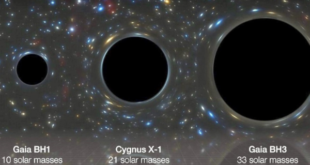Black holes can be perplexing and counterintuitive because they exist at the very edge of our current understanding of physics. Even as they’re warping the fabric of the universe, black holes have to obey certain rules. For the first time, we have direct confirmation of a vitally important property of these dead stars. Researchers from MIT and other institutions have confirmed Stephen Hawking’s black hole area theorem 50 years after the late scientist proposed it.
In 1971, the same year that astronomers spotted the first likely black hole in Cygnus X-1, Stephen Hawking devised his area theorem. According to the theorem, the area of a black hole’s event horizon can never get smaller. Hawking was able to show this worked mathematically, but many were skeptical of the apparent parallels with the second law of thermodynamics, which says entropy (or disorder) within an object will never decrease.
The area theorem could therefore mean black holes can emit thermal energy, which is very much the opposite of what you’d expect for a gaping gravitational maw that consumed anything that ventured too close. It wasn’t until a few years later that Hawking brought the two ideas together when he proposed Hawking radiation, which says that black holes could emit tiny amounts of radiation as a consequence of their quantum properties. This could have major implications in physics, and it all flowed from the idea that event horizons can’t shrink, but we didn’t have any experimental confirmation until now.
The Laser Interferometer Gravitational-wave Observatory (LIGO) began scanning the heavens for signs of gravitational waves in 2015. The first signal it spotted was GW150914, a black hole that used to be two black holes. When LIGO came online, the team didn’t have the ability to tease out event horizon measurements, but that has changed over the last several years.
The M87 supermassive black hole imaged in 2019. GW150914 is much smaller, but this is the only real picture of a black hole we have.
The researchers, led by MIT fellow Maximiliano Isi, revisited that first signal to see if they could prove the area theorem. If Hawking was right, the black hole that was left after the collision should have an event horizon that is at least as big as the total area of both precursor black holes.
Using new techniques, Isi’s team was able to pick out frequencies from the immediate aftermath of the collision that they could use to calculate the final object’s mass and spin. A black hole’s mass and spin are directly related to the event horizon area, so the team was able to measure GW150914 before, during, and after the peak in gravity waves. Before the merger, the two black holes had a combined event horizon area of 235,000 square kilometers. After the collision, the new, larger black hole 367,000 square kilometers.
With a larger event horizon, GW150914 confirms the Hawking area theorem. It’s an impressive extrapolation from gravity waves, and LIGO is only our first attempt at analyzing this phenomenon.
Now read:
Subscribe Today to get the latest ExtremeTech news delivered right to your inbox.
© 1996-2021 Ziff Davis, LLC. PCMag Digital Group
ExtremeTech is among the federally registered trademarks of
Ziff Davis, LLC and may not be used by third parties without explicit permission.
We strongly encourage you to read our updated PRIVACY POLICY and COOKIE POLICY.
Tags black confirmed gravitational hawking stephen theorem waves
Check Also
Gigabyte Shows Off Motherboard With Golden CPU Socket, Tons of Bling
Motherboards have gotten pretty outrageous over the past few years. Back in the day, spending …
 #Bizwhiznetwork.com Innovation ΛI |Technology News
#Bizwhiznetwork.com Innovation ΛI |Technology News



